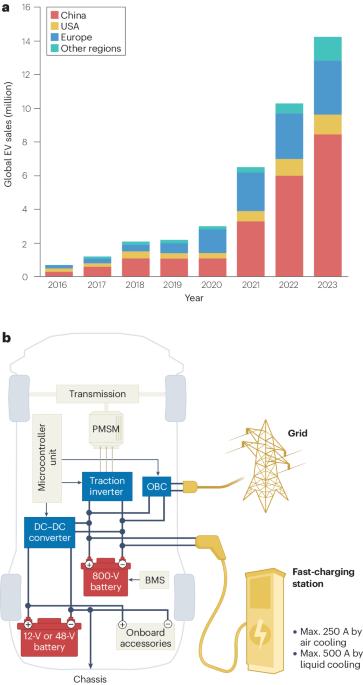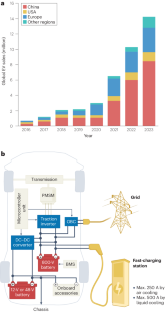Industry perspective on power electronics for electric vehicles
引用次数: 0
Abstract
Driven by the global effort towards reduction of carbon dioxide emissions from cars, the gradual phase out of fuel cars accompanied by the rise of electric vehicles (EVs) has become a megatrend. Despite the rapid growth of electric vehicle markets worldwide, the leading manufacturers recently announced notable price reductions to compete for market shares. From the technology perspective, for fast charging and extended driving range, more electric vehicles now shift to 800-V batteries with the traction inverters based on wide-bandgap SiC, which can lead to higher efficiency and higher power densities compared with the Si counterparts. However, to further reduce the SiC substrate and epitaxy cost remains a challenge. By contrast, for the DC–DC converters and onboard chargers of electric vehicles, the power switches based on GaN enable fast switching, which can significantly reduce the module form factors. However, the high-voltage reliability concerns associated with the heteroepitaxial defects affect the widespread adoption of GaN in electric vehicles. In this Review, we present a comprehensive discussion of the state-of-the-art power electronics for electric vehicles based on Si, SiC and GaN technologies from the device to circuit and module levels. Various competing technologies are evaluated in consideration of not only efficiency but also cost and reliability, which constitute the three main pillars supporting the continuous growth of electric vehicle power electronics. This Review discusses the state-of-the-art power electronics in electric vehicles based on Si, SiC and GaN from an industry perspective, with a particular focus on the module power densities, efficiencies, costs and reliabilities with the 800-V battery.


从行业角度看电动汽车的电力电子技术
在全球努力减少汽车二氧化碳排放的推动下,燃油汽车的逐步淘汰和电动汽车(EV)的兴起已成为一个大趋势。尽管全球电动汽车市场增长迅速,但主要制造商最近都宣布大幅降价,以争夺市场份额。从技术角度来看,为了实现快速充电和延长行驶里程,目前越来越多的电动汽车转向使用 800-V 电池和基于宽带隙碳化硅的牵引逆变器,这与碳化硅相比,可以实现更高的效率和功率密度。然而,进一步降低碳化硅衬底和外延成本仍是一项挑战。相比之下,对于电动汽车的直流-直流转换器和车载充电器,基于氮化镓的功率开关可实现快速开关,从而大幅降低模块外形尺寸。然而,与异外延缺陷相关的高压可靠性问题影响了氮化镓在电动汽车中的广泛应用。在本综述中,我们全面讨论了基于硅、碳化硅和氮化镓技术的最先进的电动汽车电力电子技术,从器件到电路和模块层面。在评估各种竞争技术时,我们不仅考虑了效率,还考虑了成本和可靠性,而这正是支撑电动汽车电力电子技术持续发展的三大支柱。本综述从行业角度讨论了基于硅、碳化硅和氮化镓的最先进的电动汽车电力电子技术,尤其关注 800 V 电池的模块功率密度、效率、成本和可靠性。
本文章由计算机程序翻译,如有差异,请以英文原文为准。
求助全文
约1分钟内获得全文
求助全文

 求助内容:
求助内容: 应助结果提醒方式:
应助结果提醒方式:


